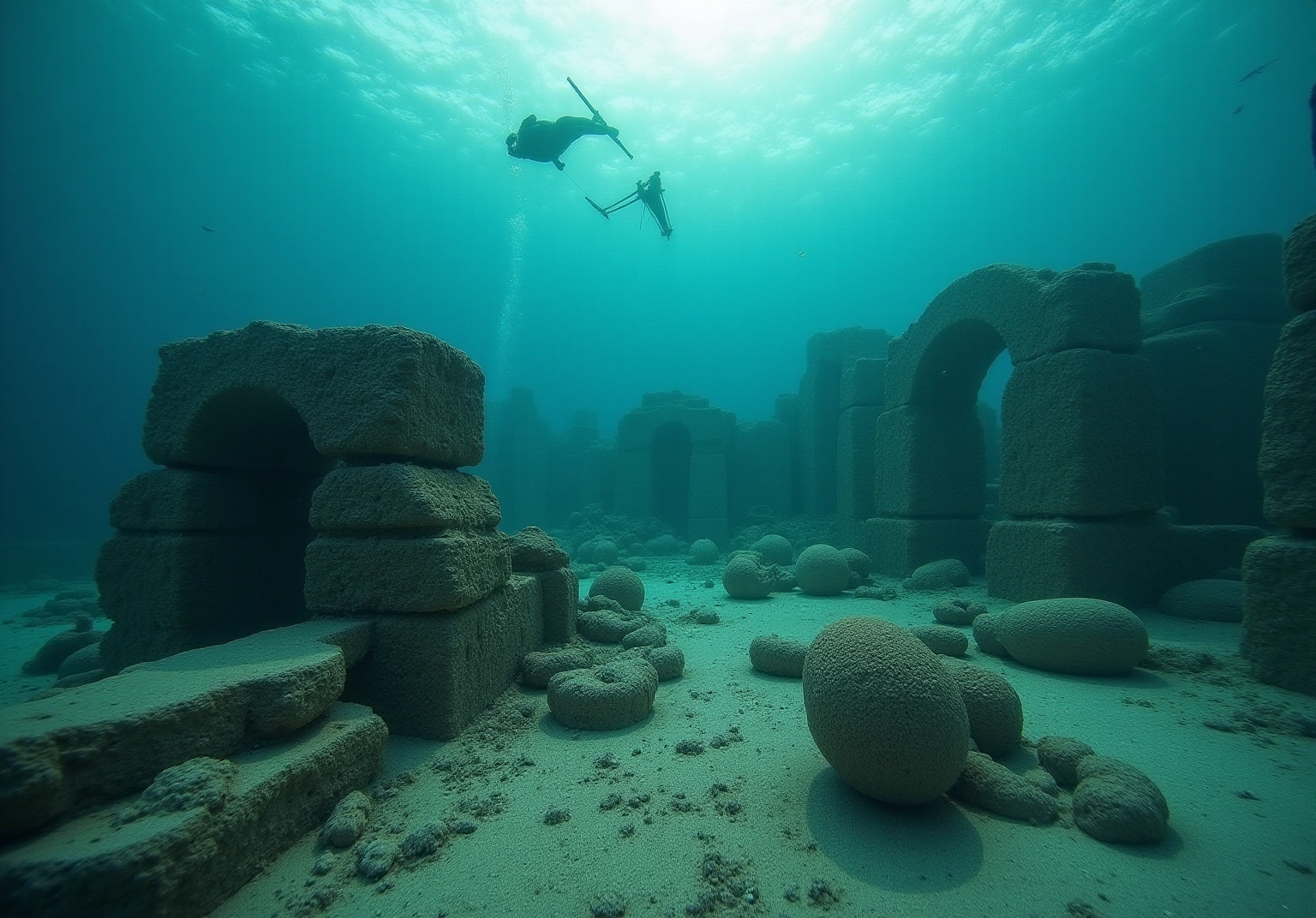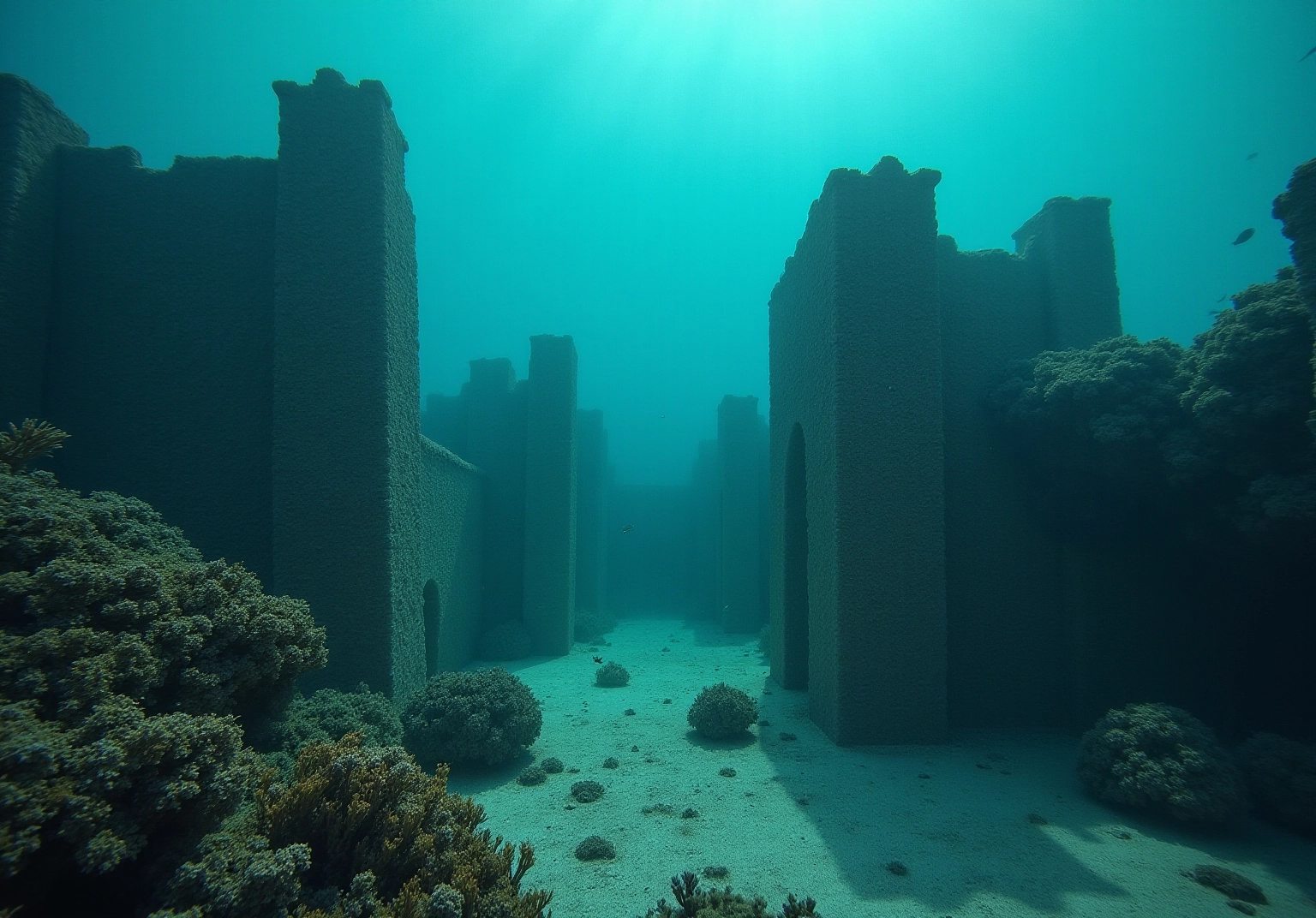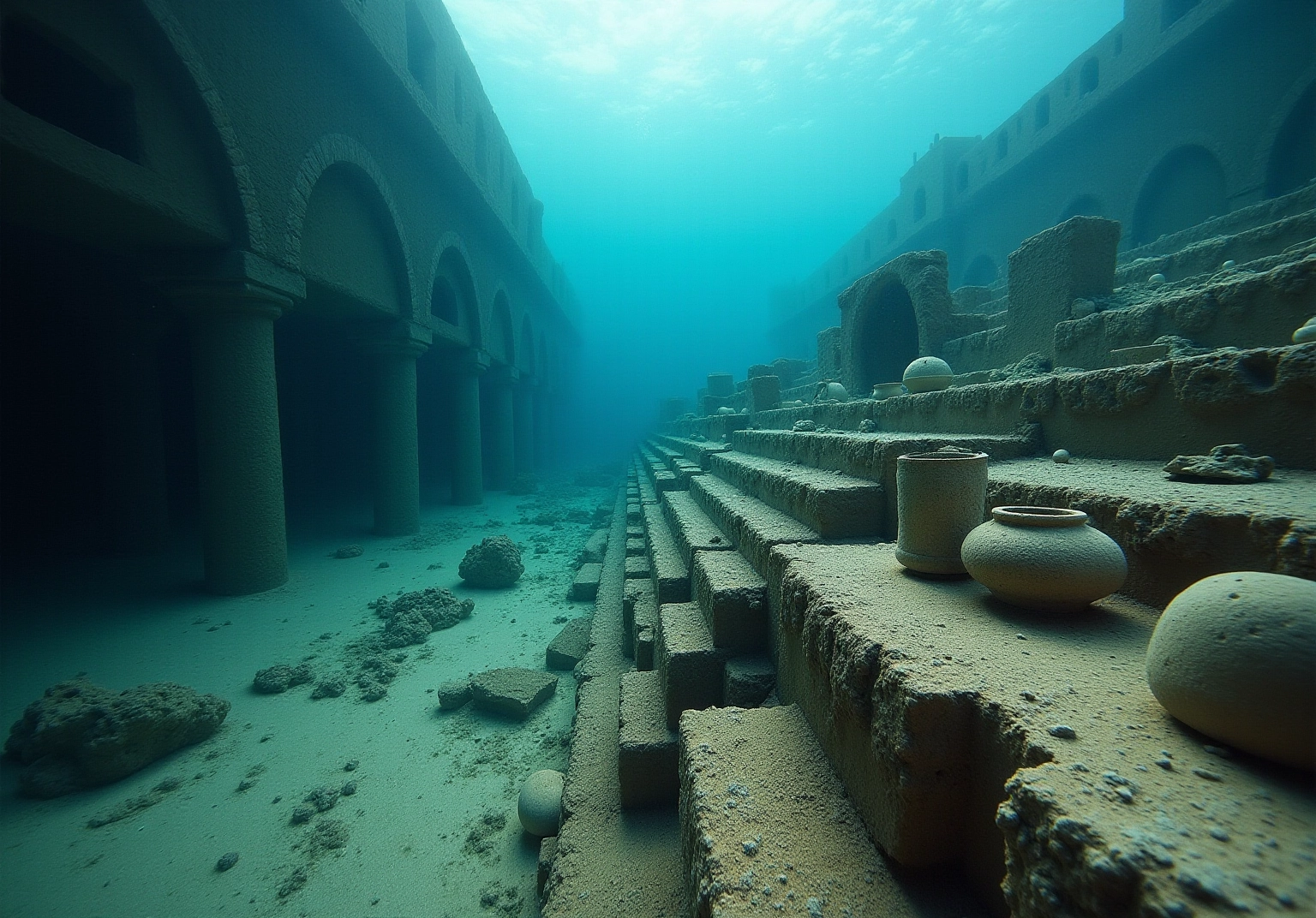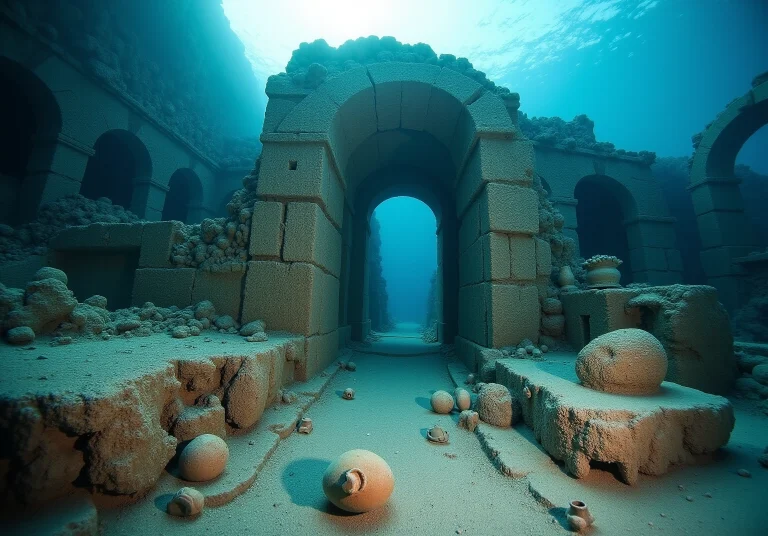Overview
Have you ever wondered about the mysteries of ancient underwater cities? This article dives into the fascinating history and significance of these submerged wonders, lost to natural disasters, rising sea levels, or even human actions. It reveals vital insights into past civilizations that you won’t want to miss!
Take Thonis-Heracleion and Dwarka, for example. These archaeological sites are not just remnants of the past; they offer incredible contributions to our understanding of ancient social structures, trade networks, and cultural resilience. Imagine exploring these underwater treasures and the stories they tell!
But here’s the catch—modern environmental threats put these sites at risk. That’s why it’s so important to emphasize the need for preservation. So, let’s embark on this journey together and uncover the stories waiting beneath the waves!
Key Highlights:
- Ancient underwater cities were submerged due to natural disasters, rising sea levels, or human actions.
- Thonis-Heracleion, discovered in 2001, sank due to earthquakes and soil liquefaction around the 8th century AD.
- Dwarka, linked to Lord Krishna, is believed to have submerged after catastrophic floods, with archaeological finds dating back to 2000 BCE.
- Exploration of these cities provides insights into ancient societies’ social structures, trade networks, and daily life.
- Natural disasters like earthquakes and tsunamis, along with human activities, contributed to the submersion of many coastal civilizations.
- The archaeological significance of underwater cities includes revealing daily life, trade practises, and cultural resilience.
- Pavlopetri showcases preserved artefacts that illuminate Minoan maritime trade routes.
- The Lion City of Qiandao Lake reflects the rich cultural heritage of submerged civilizations.
- Rising sea levels and coastal erosion pose threats to these archaeological sites, emphasising the need for preservation efforts.
- Teddy Tucker’s contributions helped professionalise underwater archaeology, highlighting the importance of structured practises in the field.
Introduction
Beneath the surface of our world’s oceans, there’s a treasure trove of history waiting to be discovered—ancient underwater cities that once thrived above sea level! Imagine exploring submerged marvels like the fabled Dwarka in India and Thonis-Heracleion in Egypt. These incredible sites offer a fascinating glimpse into the lives of civilizations that faced the relentless forces of nature and human intervention.
As researchers dive into these watery ruins, they uncover not just architectural wonders but also rich cultural narratives that reveal the complexities of trade, religion, and daily life. What secrets do these ancient cities hold? How do they challenge our understanding of history and resilience in the face of environmental change? Dive in with me, and let’s explore these captivating stories together!
Define Ancient Underwater Cities
Imagine communities that once thrived above sea level, now hidden beneath the waves! Ancient underwater cities are fascinating places that were submerged due to natural disasters, rising sea levels, or even human actions. Think of the sunken town of Thonis-Heracleion in Egypt or the legendary Dwarka in India—these underwater marvels are rich with architectural remnants, artifacts, and cultural treasures that reveal the lives of the civilizations that once called them home. Today, there are many ancient underwater cities around the world, each possessing its own unique story and architectural style that reflects its historical background.
For example, let’s dive into Thonis-Heracleion, which was discovered in 2001. This bustling port thrived until it sank around the 8th century AD, likely due to earthquakes and soil liquefaction. And then there’s Dwarka, believed to be the original settlement established by Lord Krishna, which is thought to have submerged beneath the Arabian Sea after his departure from the world. Excavations at Dwarka have uncovered stone blocks, anchors, and fortified foundations that highlight the impressive engineering skills of its builders. Interestingly, the ruins in the Arabian Sea may date back to a city-state from 2000 BCE, giving us a clearer glimpse into Dwarka’s historical context.
Exploring ancient underwater cities is key to understanding the social and economic structures of ancient societies. Experts emphasize that the archaeological finds related to ancient underwater cities not only showcase the architectural prowess of these civilizations but also provide insights into their trade networks, religious practices, and everyday life. Recent discoveries, like the lost islands near the Canary Islands that might relate to the Atlantis legend, continue to spark excitement among researchers and enthusiasts alike—it’s a testament to the enduring allure of underwater archaeology! Plus, the Quabbin Reservoir in Massachusetts, which holds four ghost towns at its bottom, serves as a poignant reminder of how human actions can shape landscapes and the stories that lie beneath the surface of the water.

Explore Historical Context and Causes of Submersion
Have you ever wondered about the mysteries surrounding ancient underwater cities that have vanished beneath the waves? The submersion of ancient underwater cities and other remarkable places can be traced back to a mix of natural disasters—think earthquakes, tsunamis, and rising sea levels—alongside human activities like land reclamation and urban development.
Take Thonis-Heracleion, for example. This fascinating city sank due to a series of earthquakes and the relentless rise of tides. And then there’s Dwarka, which is believed to have been engulfed by a catastrophic flood. Historical texts and archaeological evidence reveal that many coastal civilizations, including those that became ancient underwater cities, faced similar fates, often leading to the heartbreaking loss of entire communities and their rich cultural heritage.
Studying these events not only uncovers the past but also teaches us valuable lessons about the vulnerabilities of human settlements in our ever-changing environment. So, as you plan your next adventure, consider exploring these submerged wonders and the stories they hold—they’re waiting for you to discover them!

Assess Archaeological and Cultural Significance
The archaeological importance of ancient underwater cities is truly fascinating! These ancient underwater cities offer a unique glimpse into past civilizations, revealing so much about daily life, trade practices, and social structures. Just imagine exploring ancient underwater cities, such as the submerged settlement of Pavlopetri, where remarkably preserved pottery and tools illuminate the Minoan civilization’s maritime trade routes. It’s amazing to think about their extensive connections across the Mediterranean!
And let’s not forget the ancient underwater cities discovered in the Gulf of Cambay, which predates recognized archaeological remains by a staggering 5,000 years. This discovery really highlights how significant ancient underwater cities and other submerged archaeological findings are in understanding our history. Culturally, ancient underwater cities remind us of human resilience and adaptability, showcasing how societies have navigated environmental challenges throughout time.
Another incredible site is the Lion City of Qiandao Lake, which reflects the rich culture of ancient underwater cities. As we continue to explore and excavate ancient underwater cities, we enhance our understanding of ancient cultures and underscore the urgent need for preservation efforts. With rising sea levels and coastal erosion threatening these invaluable resources, proactive measures are essential to safeguard our aquatic heritage for future generations.
I can’t help but mention Teddy Tucker’s incredible contributions to underwater archaeology. He played a pivotal role in transforming the field from amateur efforts to a structured discipline, emphasizing the importance of professional practices in uncovering these submerged wonders. As Franck Goddio noted, much of what lies beneath the sediment remains hidden, presenting challenges that complicate preservation efforts. Isn’t it exciting to think about what else we might discover beneath the waves?

Conclusion
Ancient underwater cities are like remarkable time capsules, preserving the legacies of civilizations that once thrived above sea level. These submerged marvels, such as Thonis-Heracleion and Dwarka, not only spark the imagination but also offer invaluable insights into the histories and cultures of their respective societies. When you explore these sites, you uncover the intricate connections between human settlements and the environmental challenges they faced, highlighting the fragility of coastal communities throughout history.
This article dives into the historical context and causes of submersion, shedding light on how natural disasters and human activities have shaped the fate of these cities. From the catastrophic floods that swallowed Dwarka to the earthquakes that led to the sinking of Thonis-Heracleion, each story tells a unique narrative of loss and resilience. Plus, the archaeological significance of these underwater sites reveals fascinating aspects of daily life, trade practices, and social structures, enriching our understanding of the past. Discoveries made in places like Pavlopetri and the Gulf of Cambay remind us of the importance of ongoing research and preservation efforts.
Ultimately, studying ancient underwater cities isn’t just about uncovering remnants of lost civilizations; it’s a call to recognize the importance of safeguarding our cultural heritage against the threats posed by climate change and rising sea levels. As interest in underwater archaeology continues to grow, so does the opportunity to learn from the past and inspire future generations to appreciate and protect these submerged treasures. Engaging with these underwater wonders invites you to reflect more deeply on humanity’s relationship with the environment and the enduring stories that lie beneath the waves.
Frequently Asked Questions
What are ancient underwater cities?
Ancient underwater cities are communities that once thrived above sea level but are now submerged due to natural disasters, rising sea levels, or human actions. They contain architectural remnants, artifacts, and cultural treasures that reveal the lives of the civilizations that inhabited them.
Can you provide examples of ancient underwater cities?
Notable examples include Thonis-Heracleion in Egypt and Dwarka in India. Thonis-Heracleion was a bustling port that sank around the 8th century AD, while Dwarka is believed to be the original settlement established by Lord Krishna, submerged beneath the Arabian Sea.
When was Thonis-Heracleion discovered and what caused its submersion?
Thonis-Heracleion was discovered in 2001 and is thought to have sunk around the 8th century AD due to earthquakes and soil liquefaction.
What archaeological findings have been uncovered at Dwarka?
Excavations at Dwarka have revealed stone blocks, anchors, and fortified foundations, showcasing the impressive engineering skills of its builders. The ruins may date back to a city-state from 2000 BCE.
Why is exploring ancient underwater cities important?
Exploring these cities is key to understanding the social and economic structures of ancient societies. Archaeological finds provide insights into architectural prowess, trade networks, religious practices, and everyday life of the civilizations.
What recent discoveries have sparked interest in underwater archaeology?
Recent discoveries, such as the lost islands near the Canary Islands that may relate to the Atlantis legend, have generated excitement among researchers and enthusiasts about the potential historical significance of underwater sites.
What does the Quabbin Reservoir in Massachusetts represent in the context of underwater cities?
The Quabbin Reservoir holds four ghost towns at its bottom, serving as a poignant reminder of how human actions can shape landscapes and the stories that lie beneath the water’s surface.


































